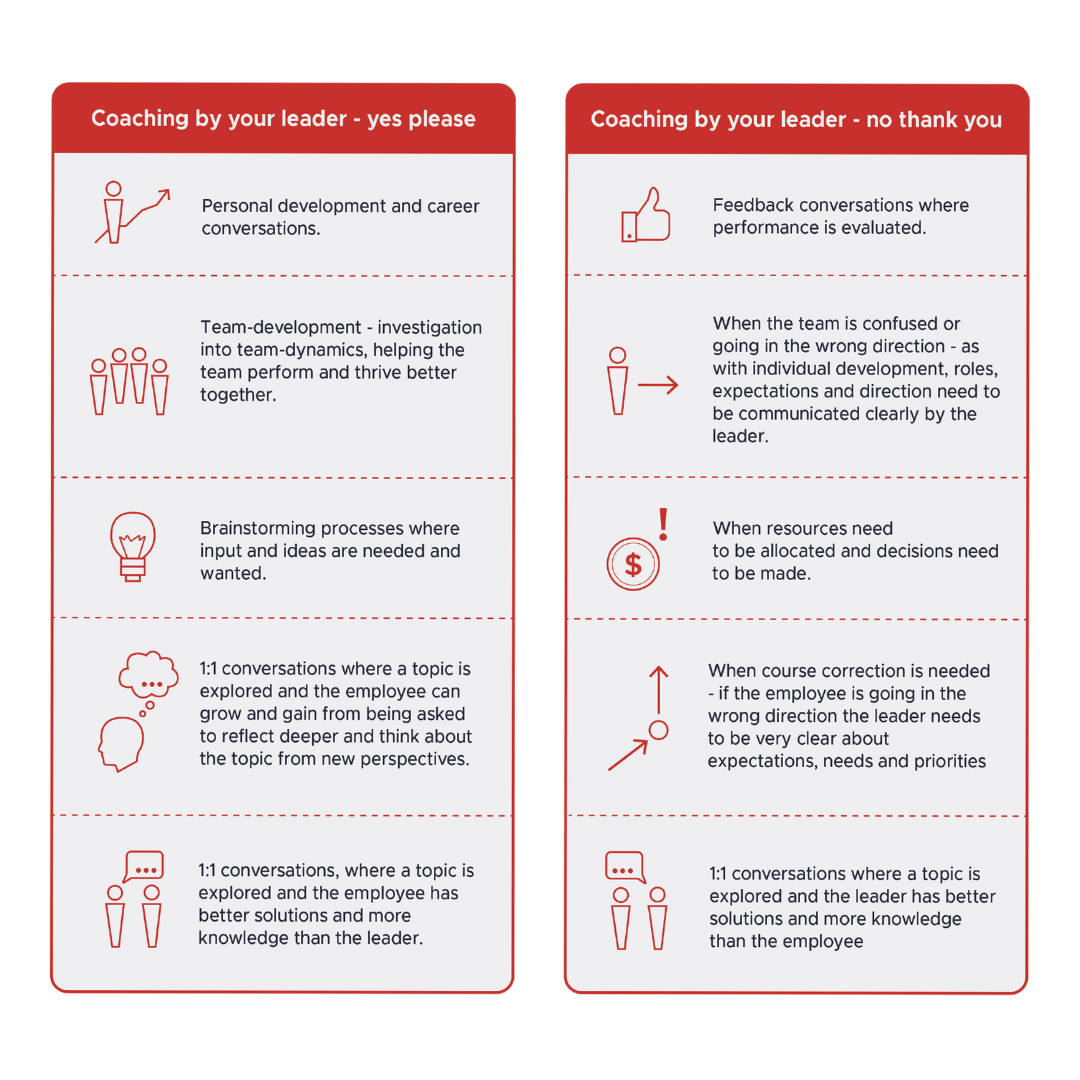87% of millennials (born between 1981 and 1996), 44% of Gen Xers (born between 1965 and 1981), and 41% of Boomers (born between 1946 to 1964) cite professional development as a priority in job hunting and as reason enough to change employers. Therefore, it should come as no surprise that today’s enterprises need professional coaching as part of their retention and recruitment strategies to remain competitive.
The aim of professional business coaching is to help the employee grow and thrive, whilst also succeeding in business critical matters. But who should be your business coach? Do organizations always need to engage with external coaches or can managers and peers be effective? What are the pros and cons of each?
In this article, we examine who is equipped to coach and how companies can get the best value for money.
Can Anyone Be a Professional Business Coach?
Simply put, no.
Professional Business Coaching is a process and a skill requiring education, training, experience, and feedback. Like anything, you can read a book, but this won’t make you an expert. Books and videos give you insight. But the real skill and value come from years of continued training, critical experience, and mentor feedback.
Coaching can be provided by leaders and managers, who use it as part of their engagement and leadership style. It can also come from internal or external coaches specifically trained to deliver business coaching.
Let us take a closer look at the difference between each type, as well as the benefits and challenges associated with each.
Leaders and Managers as the Coach
Leaders and managers who enjoy coaching and facilitation as part of their leadership style need to be aware of limitations. This is not to question their ability to lead. Far from it. But by definition, company management cannot be completely neutral in a coaching relationship with the employee and it is important to acknowledge this.
The Importance of Neutrality
Neutrality and impartiality are important when it comes to the employee learning. It allows them the freedom to trust the process, be open and honest, and explore concepts without worrying about how it will look or being immediately redirected. Both those who are receiving the coaching (the employees) and the leader know this.
“Don´t fool yourself or your employees with the illusion that leaders using coaching as part of their leadership style can be truly neutral coaches.”
They cannot. Organizational aims, time constraints, management agendas, target KPIs, and priorities impact leader neutrality. In addition, leaders are not necessarily as good at coaching employees as they think they are. A Harvard study asked 3761 executives how good they were at coaching. When they asked the employees who received the coaching, they found a drastic difference with executives significantly overestimating their talents.
When is management coaching most appropriate?
Neutrality issues do not mean that leaders can never use coaching as part of their leadership repertoire.
If they are aware of when and when NOT to apply this way of leading, as well as their own limitations when it comes to applying the coaching skills, it can be highly beneficial.
Leaders can get great benefit out of encouraging employees to:
- Generate ideas and solutions
- Think for themselves
- Challenge conventions
- Raise concerns
- Improve collaboration skills
If both parties are aware of the (hidden) power dynamics, agendas, and issues that might be at play, and if the leaders using the style have had training and education in how to coach employees, leadership can provide effective coaching.
Below are some examples of when - and when not - leaders can benefit from using the coaching style:

Internal Coaches
Internal coaches are coaches that are employed by the organization to help leaders and employees thrive and perform in their job by coaching them.
Being coached by an internal coach has some obvious benefits. The internal coach knows the organization, the internal structures, power dynamics, and the company culture well. Therefore, they are well-positioned to help the recipient in navigating those intrinsic factors occasionally missed or unappreciated by an external coach.
Purpose, Transparency, and Confidentiality Must be Prioritized
Internal coaches need to be very aware of confidentiality issues. It needs to be completely clear and transparent if the internally hired coach is to report on issues discussed. Both the coach and employee need to agree on exactly why the coaching is required, what will stay confidential, and what will not.
Internal Coaches need to make this a safe journey and not one where the employees feel they need to prove themselves or pretend.
Pressure and posturing are counterproductive to the whole idea behind coaching: to help and challenge. With the right amount of challenge - the client can grow, learn new skills and gain insights offering extraordinary benefit to their organization. This is best done in a safe environment, free from fear, ambiguity, or confusion.
External Coaches
External professional coaches can be hired either directly by a leader or employee themselves, or by HR/L&D/the management in the organization. If hired by the organization, the same benefits and drawbacks occur as with an internally hired coach.
It needs to be clear what the aim and outcome of the coaching journey is and what level of confidentiality/reporting there is, when the external coach is hired into the organization.
If the coach is externally hired, there is an additional layer of psychological safety afforded to employees. External coaches have the benefit of neutrality. They are free from bias, hidden agendas, or prior experiences. Impartiality influences the ability of a coach to stay open and curious. It also ensures the employee that anything disclosed won’t be used against them - which is crucial.
Validate External Coaching Credentials
External coaches, or full-time professional coaches, should be well-educated with comprehensive training, supervision, and feedback in coaching. Extensively educated coaches are typically certified as business and organizational psychologists with special training in coaching or hold a coaching license. Valid licenses should come from well-established coaching institutions such as the International Coaching Federation (ICF).
Sometimes external coaches come with a different educational background. What matters is the level of training they have received, and whether they have experience from coaching in organizational settings.
International Coaching Federation Certifications:
ACC: Associate Certified Coach - Proven track record of 60 hours of coaching training and 100 hours of coaching experience.
PCC: Professional Certified Coach - Proven track record of 125 hours of coaching training and 500 hours of coaching experience.
MCC: Master Certified Coach - Proven track record of 200 hours of coaching training and 2500 hours of coaching experience.
Read more about requirements to become an ICF licensed coach on ICF´s website.
Essential Coaching Skills for Business Coaches - whether they Operate as Internal or External Coaches
Elite Business Acumen
For both internal and external professional business coaches, having business acumen is paramount. Defined as “keenness and quickness in understanding and dealing with a "business situation" in a manner that is likely to lead to a good outcome”. This is an essential criterion.
Employees need someone who knows what they are talking about to inspire trust and belief in the coaching but also to assist in untangling complex problems.
The Ability to Create Continuous Learning and Development
It is important that coaches help the employee try out new behavior in real-life working situations. This ensures that learnings and insights achieved in the coaching sessions do not “just” stay in the coaching room. They become tangible, applicable and beneficial to both the individual employee as well as the organization.
Professional business coaches also give employees assignments and exercises between sessions asking them to document their progress (or even have someone film them while working on newly learned skills and behaviors). This brings the tangible and applicable benefits directly into the workplace ensuring that both the employee and organization witness solid returns on their investment.
Ultimately, what sets really good professional business coaches apart from others is their ability to resonate with employees and still serve the critical underlying business challenges experienced in today’s organizations.
Settling the Debate
The changing nature of recruitment and retention makes professional coaching and development an essential business practice, but what works best - to hire an external coach or keep it in-house?
The debate between which coach to choose often comes down to time, resources, and focus, more than between who is best equipped.
Leaders using coaching as part of their leadership style, internal as well as external coaches each have their merits. Personal experience with the organization is advantageous for leaders and internal coaches whilst external perspectives provide crucial value. All three share the desired goal of solving critical business issues for exponential success.
With the right education, leaders and internally hired staff might make a big difference in coaching their employees and peers. However, the reality is they rarely have the same level of coaching education as an externally hired coach. They usually don’t have the time to put the effort into coaching on a regular basis. And finally, the power-imbalance and confidentiality issues often undermine the progress achievable with employees.
External coaching is free from these limitations. They are specifically trained and dedicated to getting the best out of the employees with singular focus. The external coach is better positioned to instill confidence, get to the route of problems, and create specific and targeted programs to develop the employee in pursuit of career and organizational goals.
With these insights in your arsenal, we hope you are now well on your way to better understand the role of the different kind of coach and who you can trust to coach your employees.














